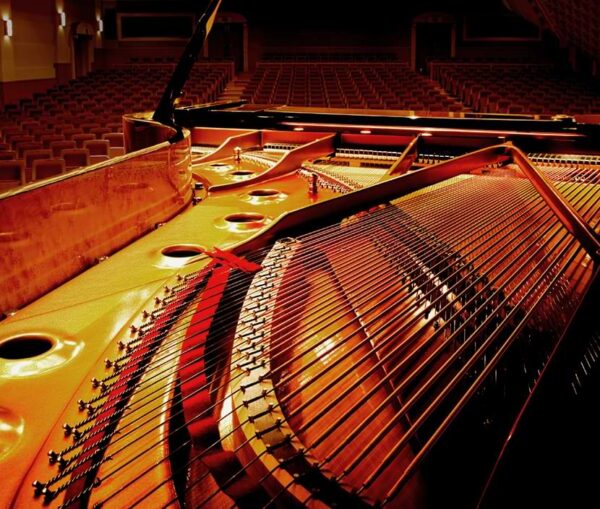PART II: SOUND TECHNOLOGY
Playing a piano can be a rewarding experience. The slightest change of pressure applied to a key not only affects the volume of the note, it changes the tonal character. Going from the smooth, demure pianissimo tones to the thunderous, percussive fortissimo tones, the piano has one of the most complex sound palates of any instrument. The physics involved with the making of a piano’s sound is complicated. It’s widely accepted that the sound of a piano is the hardest to replicate in the digital realm. This is where Kawai has made the most progress of any digital piano maker. They may not offer 400+ sounds, but they do recreate the most important one better than anyone else – the intricate sound of an acoustic piano. If you are looking for a digital piano for the purposes of playing it like a piano, Kawai is the clear choice.
A Bit Of Physics

A piano’s sound is arguably the most difficult to replicate digitally for a few reasons. The first is that more than one sound is produced when a piano note is played. These additional sounds are called harmonics. Figure 1 shows the fundamental sound plus 3 harmonic overtones (more than a dozen harmonics can be produced by a single piano note). These harmonics ‘stack’ on top of the fundamental, creating a complex waveform. The waveform at the top of figure 1 illustrates the resulting shape created by stacking the waveforms below it. Notice that it does not repeat a pattern. By contrast, instruments like violins and flutes produce simple, repetitive waveforms making them far easier to reproduce digitally (as shown in Figure 2).
Secondly, the piano’s sound is non-linear, meaning that the shape of its waveform radically changes when played loudly or quietly. It is almost as though the piano were many instruments, not all playing at once, but all playing together. There are other factors such as whether the sustain and soft pedals are engaged, the position of the top lid, the speaking length of the string, the scale design, types of wood used in the piano, etc. All of these influence a piano’s sound.

Sampling
Adding to the complicated task of digitally reproducing a piano’s sound is the process of sampling the piano. Because the piano makes a non-linear sound, taking multiple samples of each note offers a more complete profile of a piano’s sound. It is not a simple case of pointing a microphone at a piano and pressing record. There are many factors involved in the sampling process.
- choosing which piano(s) to sample
- mono or stereo sampling
- the number and types of microphones to use
- microphone placement
- number of samples to take
- at various volumes (ppp – m – fff)
- with and without the sustain pedal
- staccato and legato
- with or without room ambiance
There are 88 keys on a piano. If each note is sampled 5 different ways in stereo, that’s 880 sampled sounds. That’s a lot of data for a CPU to stitch together in real time to recreate the sophisticated sound of a piano. Many digitals only use one sample per note and rely on algorithms to recreate the tonal variations, but these algorithms fail to account for much of a piano’s nuanced sound, which is why they are dissatisfying to play. Kawai starts with numerous samples on their entry-level digitals and goes beyond 12 on their flagship models (they use proprietary technology, so getting more detailed information is near impossible). Below are overviews of Kawai’s sound technologies, starting with Harmonic Imaging and continuing through to their latest SK-EX Rendering Piano Sound Engine.
HARMONIC IMAGING (HI)
Kawai’s Harmonic Imaging works from a tonal database where each note is sampled in a variety of ways and at a number of different volumes. As the keyboard is played, Harmonic Imaging pulls from this database, building a highly detailed acoustic portrait of each note. It ensures that there is a smooth tonal and volume transition throughout the entire dynamic range. These ‘smooth’ transitions can best be thought of as the difference between riding a bike down a ramp (Harmonic Imaging) or down a set of stairs (not Harmonic Imaging).PROGRESSIVE HARMONIC IMAGING (PHI)
 When playing a fine piano, the amount of pressure applied to the keyboard not only affects the volume of the sound produced, it changes the unique tonal character of each note. Therefore, multiple samples of each key played in different ways are required to construct a realistic portrait of a piano’s sound. Kawai’s Progressive Harmonic Imaging builds upon their Harmonic Imaging technology, adding a larger tonal database to draw from, which furthers the recreation of an acoustic piano’s sound. The larger database allows for more physics modelling and resonance simulation. From gentle pianissimo to thunderous fortissimo, Kawai’s Progressive Harmonic imaging sampling technology ensures a wide variety of playing styles can be expressed throughout the entire dynamic range.
When playing a fine piano, the amount of pressure applied to the keyboard not only affects the volume of the sound produced, it changes the unique tonal character of each note. Therefore, multiple samples of each key played in different ways are required to construct a realistic portrait of a piano’s sound. Kawai’s Progressive Harmonic Imaging builds upon their Harmonic Imaging technology, adding a larger tonal database to draw from, which furthers the recreation of an acoustic piano’s sound. The larger database allows for more physics modelling and resonance simulation. From gentle pianissimo to thunderous fortissimo, Kawai’s Progressive Harmonic imaging sampling technology ensures a wide variety of playing styles can be expressed throughout the entire dynamic range.
HARMONIC IMAGING XL (HI-XL)
 Sound is defined as a disturbance of air. How air is specifically disturbed is the difference between the sound of a flute and the sound of a drum. The piano is an incredible instrument in that the way a note is initially played can disturb air in numerous ways. Think of it like the difference between an oar disturbing water as it propels a boat versus an outboard motor doing the same task. They both leave the same “wake”, but one slices thru the water initially while the other churns it.
Sound is defined as a disturbance of air. How air is specifically disturbed is the difference between the sound of a flute and the sound of a drum. The piano is an incredible instrument in that the way a note is initially played can disturb air in numerous ways. Think of it like the difference between an oar disturbing water as it propels a boat versus an outboard motor doing the same task. They both leave the same “wake”, but one slices thru the water initially while the other churns it.
Because the initial sound is so varied, Kawai’s Harmonic Imaging XL has extended the important attack portion of the piano sound sample by 120% to better capture these differing disturbances to recreate the tonal splendour of a grand piano. Additionally, HI-XL draws upon a larger tonal database, meaning that they take more samples of how each note is played. These additional, extra-long samples are why the HI-XL has such an authentic sound.
SK-EX RENDERING PIANO SOUND ENGINE
 In order to faithfully reproduce the stunning sound of a Shigeru Kawai concert grand piano digitally, Kawai has developed the SK-EX Rendering sound engine. It combines multi-channel, 88-key sampling with the latest resonance modelling technology to deliver pure acoustic piano authenticity. When SK-EX Rendering is selected for either the competition grand or concert grand sounds, players can choose from five differently prepared piano characters: classic, brilliant, romantic, rich and vintage.
In order to faithfully reproduce the stunning sound of a Shigeru Kawai concert grand piano digitally, Kawai has developed the SK-EX Rendering sound engine. It combines multi-channel, 88-key sampling with the latest resonance modelling technology to deliver pure acoustic piano authenticity. When SK-EX Rendering is selected for either the competition grand or concert grand sounds, players can choose from five differently prepared piano characters: classic, brilliant, romantic, rich and vintage.
Multi-Channel Sampling
 While digital pianos typically employ single-point stereo sampling, the SK-EX Rendering engine’s multi-channel sampling captures the sound from different points of the Shigeru Kawai concert grand. This not only allows a broader range of tonal characteristics to be reproduced, but also improves the connection felt between the keyboard and piano sound, resulting in a more authentic response to changes in dynamics. The newest iteration of multi-channel sampling, the SK-EX competition grand, recreates the sound from the player’s perspective.
While digital pianos typically employ single-point stereo sampling, the SK-EX Rendering engine’s multi-channel sampling captures the sound from different points of the Shigeru Kawai concert grand. This not only allows a broader range of tonal characteristics to be reproduced, but also improves the connection felt between the keyboard and piano sound, resulting in a more authentic response to changes in dynamics. The newest iteration of multi-channel sampling, the SK-EX competition grand, recreates the sound from the player’s perspective.
Full Resonance Modelling
The impressive Shigeru Kawai sound samples are further enriched by resonance modelling, which recreates the complex tonal interactions produced by the strings, dampers, and various other parts of an acoustic piano. The SK-EX Rendering generates resonances for the damper pedal and all 88 keys progressively (ie. in gradual amounts, not simply on or off), allowing the sound to behave – and therefore be controlled – more like an acoustic piano.Kawai’s Grand Pianos In Depth
With approximately 9,000 moving parts, the piano may be the most complicated acoustic instrument ever built. There are dozens of components that must work in
Kawai’s Digitals: Part 5 – The Rest
PART V: THE REST Beyond simply being played as an instrument, digital pianos have other features that can enhance the musical experience. With built-in lesson
Kawai’s Digitals: Part 4 – Connectivity
PART IV: CONNECTIVITY The ability to connect with technology is one of the advantages of a digital piano. From using your piano as a Bluetooth
Kawai’s Digitals: Part 3 – Piano Realism
PART III: PIANO REALISM The last two articles have explored the various Kawai actions and sound technologies. Touch and tone are paramount to any piano,
Kawai’s Digitals: Part 1 – Actions
PART I: DIGITAL PIANO ACTIONS The importance of a digital piano’s action cannot be understated. The ability to play dynamically is what makes a piano
Kawai’s Digitals: Part 2 – Sound Technology
PART II: SOUND TECHNOLOGY Playing a piano can be a rewarding experience. The slightest change of pressure applied to a key not only affects the
Kawai’s Upright Pianos In Depth
To put pianos into perspective, an average automobile engine has around 300 parts, a violin has 90, a microscope has 14, and a piano has
Kawai Digital Comparison Chart
Digital pianos are always evolving. Kawai makes a real effort to advance the realism of digital pianos. Though their work is impressive and exciting, it

